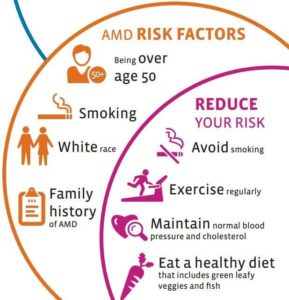 You have control over some of the known risk factors for macular degeneration. If you have macular degeneration, a family history of AMD, or are in the “macular generation” (age 60 or above), you should be particularly attentive to these. However, it is most effective to take these steps well before you are at risk. Healthy habits, started young, will provide the most benefits.
You have control over some of the known risk factors for macular degeneration. If you have macular degeneration, a family history of AMD, or are in the “macular generation” (age 60 or above), you should be particularly attentive to these. However, it is most effective to take these steps well before you are at risk. Healthy habits, started young, will provide the most benefits.
Stop Smoking
Smoking increases your risk of developing macular degeneration two to 5 times! Tobacco appears to interfere with the absorption of lutein, an important antioxidant that protects the retina. Smokers are likely to have low levels of lutein and they are at greater risk of developing macular degeneration than nonsmokers. So, if you’ve been trying to quit smoking, here’s another good reason to stop!
Control High Blood Pressure
The eye is a highly vascular organ and it has a rich supply of blood vessels. In fact, the rate of blood exchange in the eye is the highest in the body. The link between high blood pressure and AMD has been the subject of much research.
The only way to know if you have high blood pressure is to have your doctor check for it. There are no symptoms, which is why it is called “the silent killer”. If you have high blood pressure, it can be controlled by following your doctor’s instructions. This may involve changes in diet and/or medication.
Protect Your Eyes From Exposure to Harmful Sunlight
Ultraviolet light and blue light can damage your retina and may increase your chances of developing macular degeneration. They can also speed up its development. Therefore, it is extremely important to protect your eyes when you are out of doors.
Wear a hat or visor whenever you are outside, even on overcast days. Ultraviolet light passes through cloud cover and is just as dangerous as direct sunlight.
Look for sunglasses that screen 99-100% of ultraviolet A and B rays. Recent research points to blue light (the short wavelengths of the light spectrum) as an even more damaging factor. To be on the safe side, try to find glasses that guard against both ultraviolet rays and bluelight. A certain percentage of sunglasses are mislabeled, so always buy sunglasses from a reputable dealer. Your optician can check your glasses to measure the UV protection.
Most glasses allow some direct sunlight to enter from the top and sides of the frame. There are sunglasses designed specifically for macular degeneration that include side panels and a ridge at the top of the glasses so that all light is filtered. The most helpful colors for blocking out blue light are red, orange, yellow and amber. Because glare is often a problem for people with AMD, choose this protection carefully. You can also have your regular glasses treated with ultraviolet protection – a clear coating that will not interfere with your sight.
Eat a Healthy Diet
The diet widely recommended as beneficial for cardiovascular good health – low in saturated fats, high in fruits and vegetables – also seems to help people suffering from AMD. A healthy lifestyle that includes regular cardiovascular exercise also contributes to both cardiac and eye health. One explanation: A healthy heart speeds the delivery of essential nutrients to the eyes and hastens the removal of waste products. Other studies have noted beneficial changes from a diet rich in dark green leafy vegetables such as spinach, kale, mustard and collard greens. Antioxidants are present in fruits and vegetables with bright color, including red grapes, peppers, corn, oranges, cantaloupe and mango.
